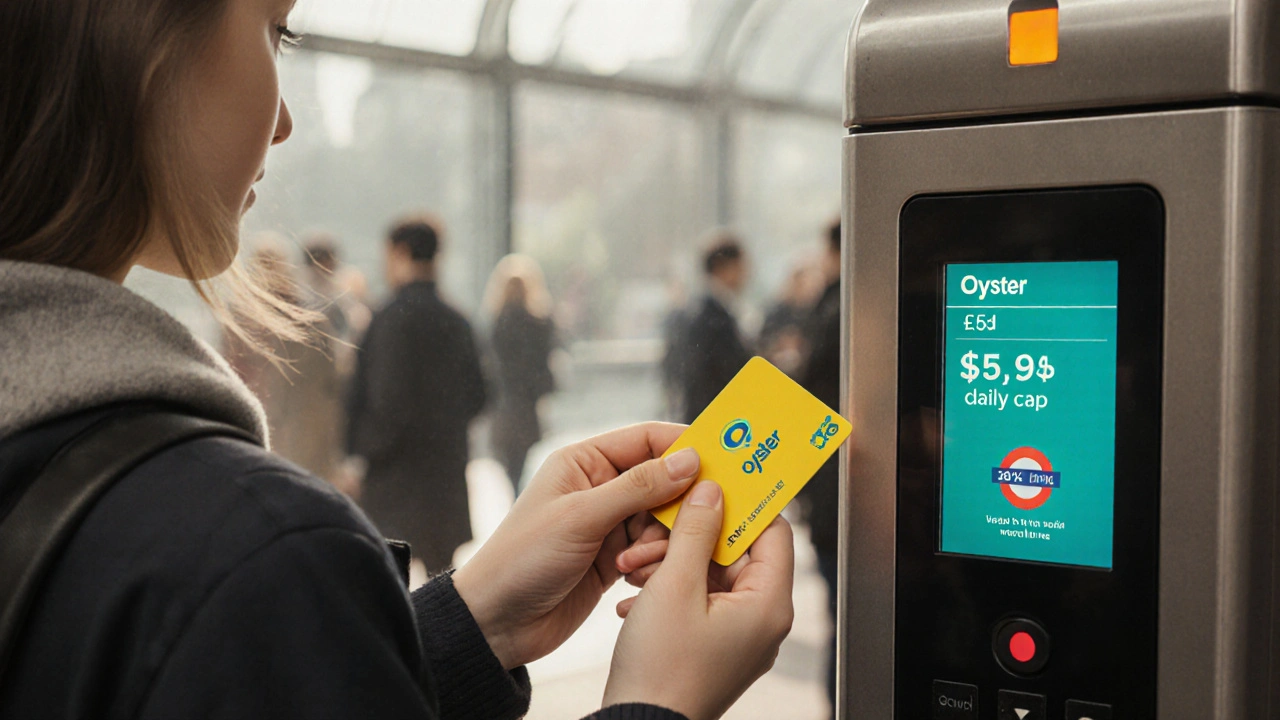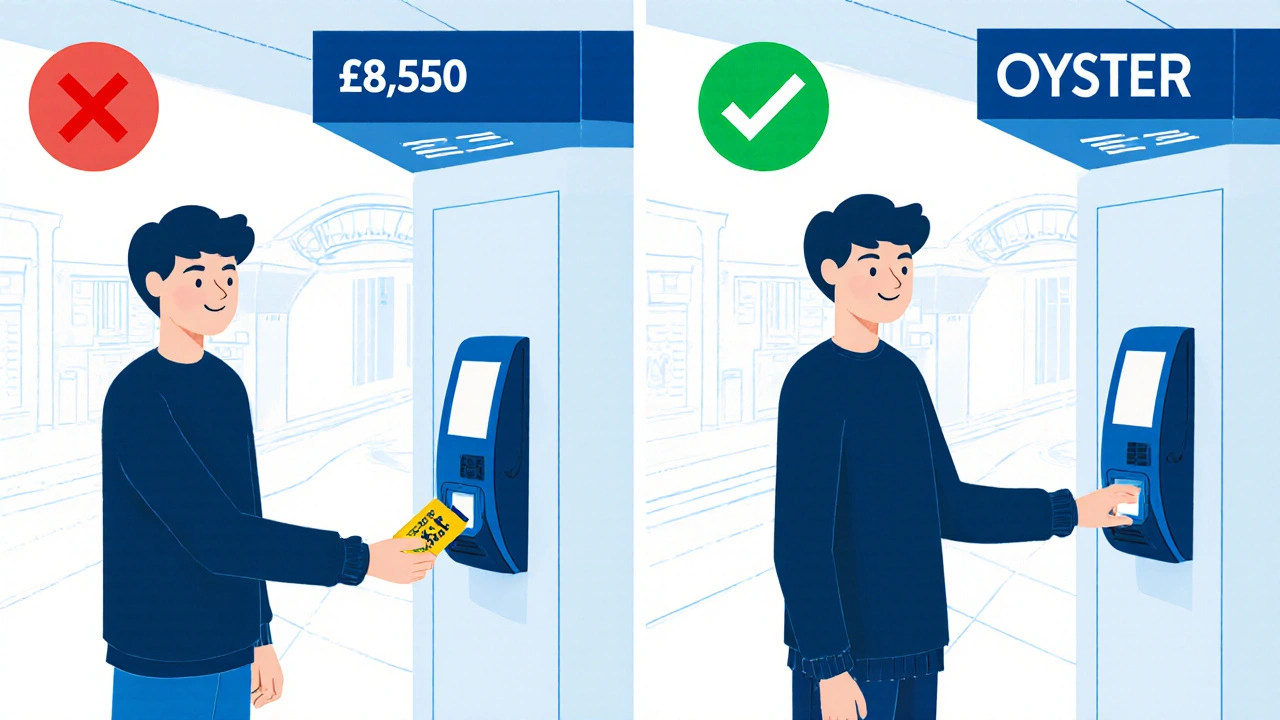
If you’re a student in London, your monthly transport bill can eat up a big chunk of your budget. Two options dominate: the Oyster card and contactless payment. Both let you tap and go, but only one saves you real money over time. And it’s not always the one you think.
How Oyster Cards Work for Students
The Oyster card is a reusable smart card issued by Transport for London (TfL). For students, it’s not just a payment tool-it’s a gateway to discounts. If you’re aged 18 or over and enrolled in a full-time course at a London-based school, college, or university, you can apply for a 18+ Student Oyster card. This gives you 30% off Pay As You Go fares on buses, trams, Tube, DLR, London Overground, and most National Rail services within London.
You load money onto the card, and it automatically caps your daily spending. For example, if you take a Tube ride in Zone 1-2 in the morning and a bus in the afternoon, you won’t pay more than £8.50 for the day (as of 2025). That’s the daily cap. But with the 30% student discount, that drops to £5.95. Weekly caps also apply, so if you travel five days a week, you’ll never pay more than £42.40 after the discount.
Here’s the catch: you need to apply for the student discount separately. It’s not automatic. You upload proof of enrollment, wait for approval, and then link your Oyster card to your student discount online. It takes 3-5 working days. If you forget, you’re paying full price-no discount, no savings.
How Contactless Payments Work
Contactless payment means using your debit or credit card, or your phone with Apple Pay or Google Pay, to tap on the reader. No registration needed. No application. Just tap and go.
TfL treats contactless payments the same as Oyster for fare capping. Same daily and weekly caps. Same 30% discount? No. That’s the key difference.
Contactless doesn’t offer student discounts. Not even a little. Even if you’re a full-time student with a valid student ID, TfL doesn’t recognize your status unless you’ve got an Oyster card linked to your student discount. So if you use your Visa or Mastercard, you pay full adult fares. That’s £8.50 per day for Zones 1-2, not £5.95.
Some students think, “I’ll just use contactless and forget the Oyster.” But that’s like leaving money on the table. Over a 40-week academic year, that difference adds up.
Real Cost Comparison: Oyster with Discount vs. Contactless
Let’s say you’re a student commuting daily from Zone 2 to Zone 1-5 days a week, 40 weeks a year. Here’s what you actually pay:
- Oyster with 30% student discount: £5.95 daily cap × 5 days = £29.75 per week. £29.75 × 40 weeks = £1,190 per year.
- Contactless (full fare): £8.50 daily cap × 5 days = £42.50 per week. £42.50 × 40 weeks = £1,700 per year.
That’s a difference of £510 a year. That’s not just a few coffees. That’s a round-trip flight to Lisbon, or half a semester’s textbooks. Or a new laptop.
And this doesn’t even include the weekly cap benefit. With Oyster, you hit the weekly cap of £42.40 after five days. With contactless, you pay £42.50 every week. The weekly cap doesn’t give you extra savings-it just stops you from paying more than the cap. But the discount does.

What About Bus-Only Travel?
If you only take buses, the math changes slightly-but not in favor of contactless.
Bus fares are flat: £1.75 per ride, regardless of distance. With Oyster and the student discount, you get 50% off, so you pay £0.88 per ride. And you get a free bus transfer within an hour. So if you take two buses a day with a transfer, you pay £0.88 × 2 = £1.76 per day. Daily cap for buses is £5.25 after discount (vs. £5.25 full fare-no cap reduction).
With contactless, you pay full £1.75 per ride. Two buses = £3.50 per day. Daily cap for buses is £5.25. So if you take more than three buses in a day, you hit the cap. But if you take two, you pay £3.50 vs. £1.76 with Oyster. That’s nearly double.
Even for bus-only students, Oyster with discount wins.
When Contactless Might Make Sense
There are two real cases where contactless could be better:
- You’re only in London for a few weeks. If you’re doing a short exchange program, internship, or summer course, applying for a student Oyster card isn’t worth the paperwork. Use contactless. You’ll pay more per ride, but you avoid the wait and hassle.
- You don’t have a UK bank account. Oyster cards can be loaded with cash at stations, but the 30% discount requires online registration with a UK payment method. If you’re an international student without a UK card or bank account, contactless via your foreign card (even with fees) might be your only option. But check if your bank charges foreign transaction fees-it could eat into any savings.
For everyone else-full-time students living in London for the semester or year-contactless is just paying more.
Common Mistakes Students Make
Here’s what goes wrong:
- Using contactless and thinking they’re getting the discount. They’re not. TfL doesn’t auto-apply student discounts to contactless. Only Oyster cards do.
- Forgetting to register the Oyster card with the student discount. You get the card, then don’t link it. Result: full price.
- Using someone else’s Oyster card. Oyster cards are personal. If you use a friend’s card, you’re not getting the discount, and you risk a fine if caught.
- Assuming Apple Pay or Google Pay = discount. Nope. It’s still contactless. Same full price.
One student I talked to used contactless for six months before realizing she was paying £500 extra. She switched to Oyster, got the discount, and got a refund for the overpayment. TfL doesn’t refund overpayments automatically-you have to request it. But they will if you prove you were eligible.

How to Get the Student Oyster Card Right
Here’s the step-by-step:
- Go to tfl.gov.uk/18plusstudent and apply online.
- Upload proof of enrollment (student ID, course confirmation letter).
- Wait 3-5 days for approval.
- Order your Oyster card (free to order, £7 refundable deposit).
- Once it arrives, log in to your TfL account and link the card to your discount.
- Top up with £10-20 and start tapping.
Pro tip: Do this before term starts. Don’t wait until week two. You’ll lose savings.
What About Travelcards and Season Tickets?
If you’re commuting the same route every day, a monthly or annual Travelcard might seem better. But for most students, it’s not.
For Zones 1-2, a monthly Travelcard costs £142.80. With the 30% student discount, it drops to £99.96. That’s cheaper than paying daily caps if you travel 22+ days a month. But most students don’t travel every single day. Weekends, holidays, sickness, exams-you miss days. So daily capping with Oyster gives you flexibility. You only pay for what you use. A Travelcard is a fixed cost. If you miss three days, you’ve wasted £13.64.
For most students, Pay As You Go with Oyster + discount is the smarter move.
Final Verdict
For any student living in London for more than a month, the Oyster card with the 18+ Student discount saves you hundreds of pounds a year. Contactless is convenient-but expensive. It’s the easy choice. Oyster is the smart choice.
You don’t need a fancy app. You don’t need to juggle multiple cards. Just one Oyster card, linked to your discount, and you’re set. Tap. Go. Save.
Don’t let convenience cost you money. The math is clear: Oyster wins.
Can I use my contactless card and still get the student discount on London transport?
No. Transport for London (TfL) only applies the 30% student discount to Oyster cards that are registered with your student status. Contactless payments-whether from a debit card, credit card, Apple Pay, or Google Pay-do not qualify for any student discount. You’ll pay full adult fares.
How much money can I save with a student Oyster card versus contactless?
If you commute five days a week for 40 weeks a year in Zones 1-2, you’ll save £510 annually. With contactless, you pay £8.50 per day (daily cap). With a student Oyster card, you pay £5.95 per day after the 30% discount. That’s £2.55 saved per day, or £510 per year.
Do I need to be 18 or older to get the student Oyster discount?
Yes. The 30% discount is only available to students aged 18 and over. Students under 18 qualify for a different discount through the 16+ Zip Oyster photocard. If you’re 18 or older and enrolled in full-time education in London, you’re eligible for the 18+ Student Oyster card.
Can I use my Oyster card on National Rail services in London?
Yes. The 18+ Student Oyster card works on most National Rail services within London zones, including services operated by Thameslink, Southeastern, and Great Northern. It does not work on long-distance trains outside London or on Heathrow Express or Eurostar.
What happens if I forget to link my Oyster card to my student discount?
You’ll pay full adult fares until you link your card. Once you link it, the discount applies from the next time you tap in. TfL does not refund overpayments retroactively unless you request it. You can contact TfL customer service to claim back overpayments if you were eligible but didn’t link your card in time.
Is the student Oyster card free to get?
Yes, the Oyster card itself is free to order. There’s a £7 refundable deposit when you first load it, which you get back when you return the card. The student discount is also free-you don’t pay extra to apply for it. Just make sure you’re eligible and apply online through TfL’s official website.
Can I use my student Oyster card outside London?
No. The 18+ Student Oyster card only works within London’s fare zones (Zones 1-9). It doesn’t work on trains outside London, like to Brighton, Oxford, or Cambridge. For trips outside London, you’ll need to buy a separate ticket or use contactless if your card supports it.